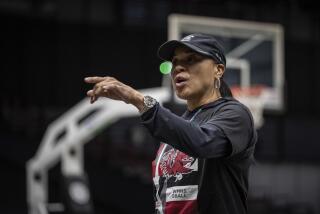Official Decries Gap Between Rich, Poor : Economy: The labor statistics chief chides White House, Congress for lack of leadership. She says she is ‘very worried’ about growing polarization.
- Share via
WASHINGTON — Janet L. Norwood, veteran U.S. commissioner of labor statistics, decried Washington’s lack of leadership on economic problems Tuesday, saying that the country is being polarized by the growth of the most severe gap between the poorest and richest Americans that she has seen in 38 years of government service.
“There’s a lot of posturing going on,” she said, but neither Republicans nor Democrats have come up with an answer to economic problems that plague the country and leave the poorest Americans worse off than ever.
Although the Commerce Department reported Tuesday that the economy technically pulled itself out of the recession in the third quarter by growing 2.4%, Norwood said she sees no sign that the nation is creating the new jobs necessary for true recovery.
She declared that the nation must be mobilized to solve the problem, adding: “We need leadership, but I don’t think it can come just from government. It clearly isn’t coming right now from the Congress or the President.”
Norwood, who has served almost 12 years as the politically independent head of the Bureau of Labor Statistics, was first appointed to a four-year term by President Jimmy Carter and was reappointed twice by Ronald Reagan. She recently informed President Bush that she does not want to be reappointed and will retire at the end of the year to become a senior fellow at the Urban Institute, a Washington think tank.
In a breakfast session with Times Washington Bureau reporters and editors, she cited the growing gap between the rich and poor and said: “I am very worried, extraordinarily concerned, about the polarization that I see going on in our country.”
It used to be that almost everyone on the income scale moved up, she said, so that people on the bottom saw their situation improving. Now, she said, the bottom group is “splitting”: Some are moving into the middle class, but those left behind are “sinking.”
“You can’t have a democratic system if you increasingly have haves and have-nots,” she declared.
A study released three months ago by the nonprofit Center on Budget and Policy Priorities, a liberal think tank, showed that the income gap between rich and poor widened dramatically during the 1980s. Average incomes increased 122% after taxes for the top 1% of households, but fell 10% for the bottom fifth. Income for the top 1%, measured in 1991 dollars, rose from an average of $203,000 per household in 1977 to $451,000 in 1988.
The Census Bureau’s 1990 report on income showed that the top 20% of Americans received 46.8% of all the household income while the bottom 20% received 3.9% of all household income.
Norwood said that she is also “terribly concerned” that American educational standards are deteriorating compared to those of other countries and that many young people, especially minority members, are left without the skills, values and general background necessary for employment.
The Bureau of Labor Statistics, she said, is trying to develop a pilot survey of employers to find out what they are doing to educate workers and what they are looking for in workers they hire. Small surveys done by various commissions indicate that employers are primarily interested in people “who have a work ethic, who come to work on time, who are able to be polite and civil and who will dress decently in the workplace and so on,” she added.
A “restructuring of occupation” is going on in industry today, she said, as employers are increasingly recognizing that they also need workers who can think more and have more technical skills. And that exacerbates the problem of the have-nots, especially minority youths who lack the opportunity to get the necessary technical training.
When asked if that message had gotten through to the Bush Administration, she said: “I’m not sure it has gotten through in the sense that action is to be taken or that programs are being developed for it, because I think there’s a philosophical difference of view there.”
If part-time employees who would like to have full-time jobs were included in the total unemployment rate, the combination of unemployment and underemployment would surge above 10%, she said. About 120 million Americans are employed full time, and 6 million part-timers say that they would like to be working full time. An additional 15 million are working part time by choice.
The 6 million part-timers looking for full-time jobs are disproportionately black, Latino and female and tend to have fewer skills than other workers, she said, although the balance may be shifting because this recession has been unusually hard on white-collar workers.
More to Read
Get the L.A. Times Politics newsletter
Deeply reported insights into legislation, politics and policy from Sacramento, Washington and beyond. In your inbox twice per week.
You may occasionally receive promotional content from the Los Angeles Times.









